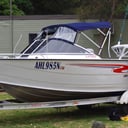What is a phreatophyte?
Phreatophytes are plants that use water from a nearby stream or water source, and are generally considered to be nuisances because they reduce the amount of water available for other purposes. Examples of phreatophytes include cottonwood, mesquite, tamarisk or salt cedar, and Russian olive trees. Tamarisk or salt cedar trees, such as the one shown in the photo above, are non-native invaders brought by European settlers to the western United States and planted along stream banks to reduce erosion and stream channel movement during high water flows. Other phreatophytes are native to the western United States, such as cottonwood trees.
Phreatophytes are seen as competitors for limited water supplies. Phreatophytes have very long tap roots and draw down surface water flows in streams by taking it from the ground through their roots. In addition, phreatophytes such as tamarisk create adverse environmental conditions for other plants and out-compete native plants by dropping salt on the soil and making it too saline for other plants to survive. It is very hard to eradicate phreatophytes because of the length of the tap roots and their wide-spread adaptation to the western United States. Phreatophytes remain a significant concern to water users in the western United States.
More Info:
en.wikipedia.org












